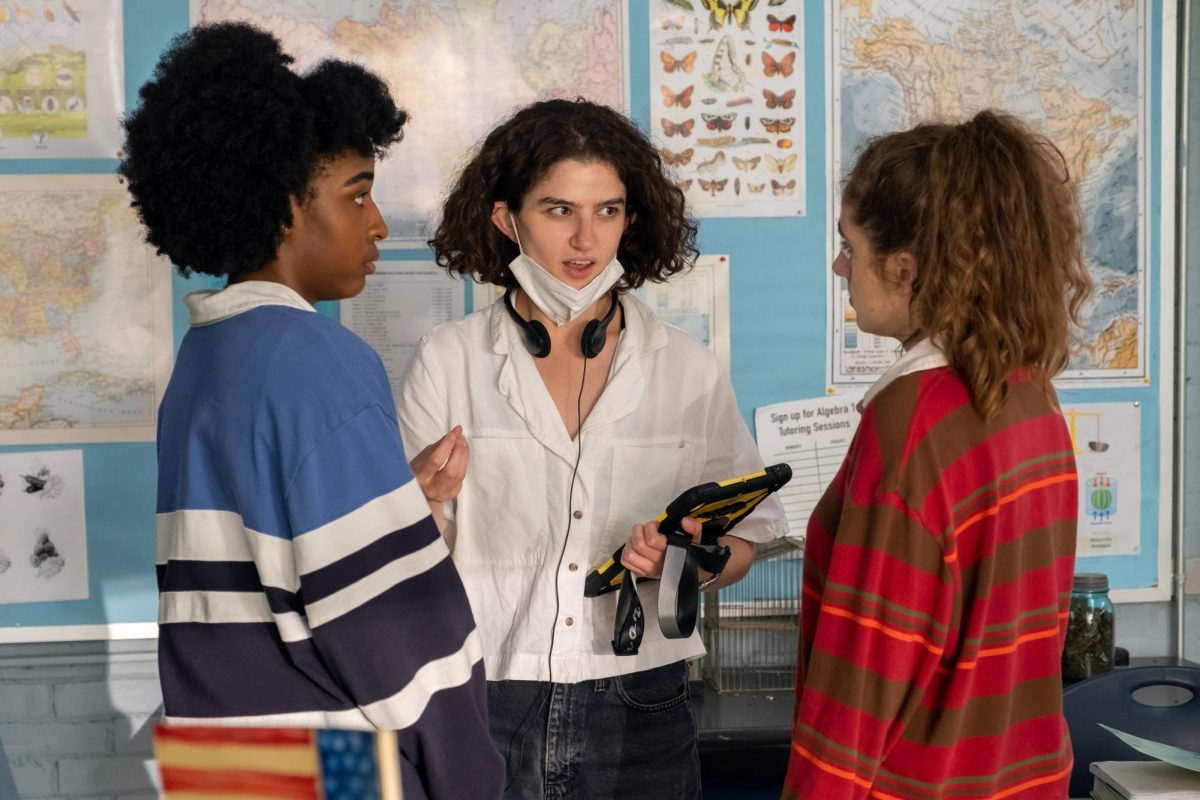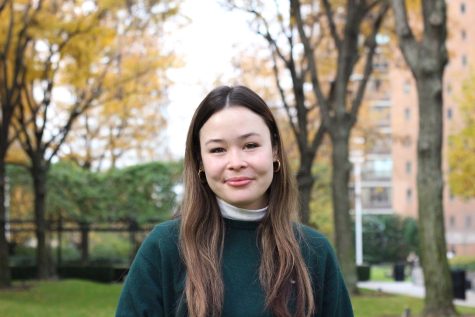From the moment a loudspeaker summoned the “ugly, untalented gays” to the principal’s office in the first trailer release for “Bottoms,” I knew the movie would be right up my alley. The sophomore feature of “Shiva Baby” director Emma Seligman, “Bottoms” follows best friends PJ (Sennott) and Josie (Ayo Edebiri), two awkward lesbian teens trying to navigate their stereotype-ridden, football-obsessed high school from the very bottom of the social food chain. The film presents a screenplay from Seligman and Rachel Sennott and received a 95% Rotten Tomatoes score followed by immense critical acclaim.
When the film begins, PJ has decided that this is their year — the year everything will change; PJ and Josie will finally elevate their social status and each get a chance with their respective crushes, cheerleaders Brittany (Kaia Gerber) and Isabel (Havana Rose Liu).
Josie reluctantly follows PJ’s lead until they are caught in an intricate web of lies involving a fake stint in juvenile detention, a rumored brawl with the school’s star football player (Nicholas Galitzine) and the creation of an all-female fight club: (read: a “self defense club”) where girls can theoretically learn to defend themselves in the name of “female solidarity.”
Truthfully, PJ convinced Josie to start the club so they could talk to girls like Brittany and Isabel — and maybe even engage in some unusually horny wrestling in the school gymnasium. With the help of eccentric classmate Hazel (Ruby Cruz) and questionable club sponsor Mr. G (NFL running back Marshawn Lynch), PJ and Josie work to climb the popularity ladder and end up succeeding, until things eventually get out of control.
“Bottoms” truly has it all. The characters Seligman and Sennott created are almost scarily realistic — you know them, you love them, and you see them at Fordham Lincoln Center. Hazel was almost definitely in line for the Boygenius concert I went to last month. The music couldn’t be more fitting, with a score by gay icon Charli XCX plus a couple 2000s classics — there were audible whispers of “Oh my God” in my theater when the audience heard the intro to Avril Lavigne’s “Complicated.” Comparable to the teen dramas of the Y2K era (“Mean Girls,” “Clueless,” and even “Glee”), the humor is outrageous and the stakes are high: PJ and Josie’s group of misfit girls may be the only thing standing between Rockbridge Fall High School and tragedy at the hands of their rival football team. Not to mention their quest to avoid being “the only girl virgins at Sarah Lawrence,” according to PJ.
The undeniable scene stealer is Edebiri — actress, comedian, writer and New York University alum. Her comedic timing had the audience in shambles both times I saw the film. This year, she seems to be everywhere: While she may be best known for her role as Sydney in Hulu’s “The Bear,” which earned her her first Emmy nomination for outstanding supporting actress in a comedy series, Edebiri has also been in “Abbott Elementary,” “Spiderman: Across The Spiderverse,” “Theater Camp” and “Big Mouth.”
“Bottoms” truly has it all. The characters Seligman and Sennott created are almost scarily realistic — you know them, you love them, and you see them at Fordham Lincoln Center.
As Josie, she is lovable, adorably awkward and indisputably hilarious, from her minuscule eye twitches when Isabel looks her way, to a dramatic monologue detailing what Josie’s life would be like if she decided to forgo women and settle down as the beard to a gay pastor. Every performance in “Bottoms” is larger than life. Mr. G is coping with his divorce by reading pornographic magazines during school hours, Hazel has a concerning affinity for bombs and the school’s top wrestler attends class locked in a cage in the back corner.
My roommate and I grabbed hands and cracked up when Josie and Isabel hung out at “But I’m a Diner,” a reference to the classic film “But I’m a Cheerleader.” The 1999 film is often hailed as one of the iconic pieces of queer cinema, the plot focuses on young queer people undergoing a comedic version of “conversion therapy.” I could have jumped out of my chair when the waitress flashed a nametag that read, “Natasha” (a reference to the film’s star Natasha Lyonne, my personal favorite straight-woman-gay-icon). The nod to the beloved rom-com is telling, though: From the 90s to present day, on screen representation for queer women is lacking. But it doesn’t have to be, at least, anymore.
Although at the time, “But I’m a Cheerleader.” was considered a box-office failure, it has grown into a cult-classic movie that many young queer women have enjoyed over decades. The trajectory of “Bottoms,” however, has differed greatly, grossing over seven million dollars between theaters in the U.S. and Canada. The numbers tell the story: Young LGBTQ+ audiences want to see movies that feature queer women.
The queer community has made strides as a whole within the entertainment industry, with films like “Love, Simon,” “Call Me by Your Name” and “Red, White, & Royal Blue” receiving mainstream recognition over the years. Still, a majority of successful LGBTQ+ stories in film and TV are focused on men, and often representation is limited to heart wrenching dramas involving closeted love, disavowing parents and/or religious trauma. I can’t come up with a single other high school comedy with two out lesbians at the forefront, and I think that’s where “Bottoms” gets its edge.
“Our goal was to make a queer teen story that wasn’t traumatic and that also wasn’t a cutesy, earnest, like non-sexual story. It felt really freeing to be able to tell something with more messy, real queer teens in it,” Seligman said in an interview with Deadline.
As we left the theater, my roommates and I couldn’t stop talking about when we could see “Bottoms” again. We agreed wholeheartedly that the film has certainly earned a spot in the movie hall of fame in our apartment — right next to “But I’m a Cheerleader.” I can confidently say the camp-tastic teen comedy may be one of the best movies I’ve ever seen.


